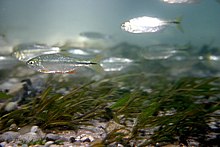| Astyanax | |
|---|---|

| |
| Astyanax mexicanus | |
| Scientific classification | |
| Domain: | Eukaryota |
| Kingdom: | Animalia |
| Phylum: | Chordata |
| Class: | Actinopterygii |
| Order: | Characiformes |
| Family: | Characidae |
| Subfamily: | incertae sedis |
| Genus: | Astyanax S. F. Baird & Girard, 1854 |
| Type species | |
| Astyanax argentatus Baird & Girard, 1854
| |
| Synonyms | |
|
Anoptichthys Hubbs & Innes, 1936 | |
Astyanax is a genus of freshwater fish in the family Characidae of the order Characiformes. Some of these fish, like many of their relatives, are kept as aquarium pets and known collectively as tetras. With around 150 described species and new ones being described yearly,[2] this genus is among the largest of the entire order; Hyphessobrycon also has more than 145 species and which one is larger at any one time depends on whether more species have been recently described in one or the other. The blind and colorless cave tetra of Mexico is a famous member of the genus, but its taxonomic position is disputed: Some recognize it as part of the Mexican tetra (A. mexicanus) and this is supported by phylogenetic evidence,[3][4][5][6][7] but others recognize the cave form as a separate species, A. jordani.[2]
The type species is A. argentatus, now regarded as a form of the Mexican tetra (A. mexicanus). The generic name comes from Astyanax, a character in Greek mythology, who was the son of Hector of Troy; in homage to this, several specific epithets also refer to the Iliad.[2]
- ^ Cite error: The named reference
Schmitter2016was invoked but never defined (see the help page). - ^ a b c Froese, Rainer; Pauly, Daniel (eds.). "Species in genus Astyanax". FishBase. October 2016 version.
- ^ Jeffery W (2009). "Regressive evolution in Astyanax cavefish". Annu. Rev. Genet. 43: 25–47. doi:10.1146/annurev-genet-102108-134216. PMC 3594788. PMID 19640230.
- ^ Dowling TE, Martasian DP, Jeffery WR (2002). "Evidence for multiple genetic forms with similar eyeless phenotypes in the blind cavefish, Astyanax mexicanus". Mol. Biol. Evol. 19 (4): 446–455. doi:10.1093/oxfordjournals.molbev.a004100. PMID 11919286.
- ^ Bradic, Martina; Beerli, Peter; García-de León, Francisco J; Esquivel-Bobadilla, Sarai; Borowsky, Richard L (2012). "Gene flow and population structure in the Mexican blind cavefish complex (Astyanax mexicanus)". BMC Evolutionary Biology. 12 (1): 9. doi:10.1186/1471-2148-12-9. PMC 3282648. PMID 22269119.
- ^ Strecker U, Faúndez VH, Wilkens H (2004). "Phylogeography of surface and cave Astyanax (Teleostei) from Central and North America based on cytochrome b sequence data". Mol. Phylogenet. Evol. 33 (2): 469–481. doi:10.1016/j.ympev.2004.07.001. PMID 15336680.
- ^ Keene; Yoshizawa; McGaugh (2016). Biology and Evolution of the Mexican Cavefish. Elsevier Science. pp. 77–87. ISBN 978-0-12-802148-4.